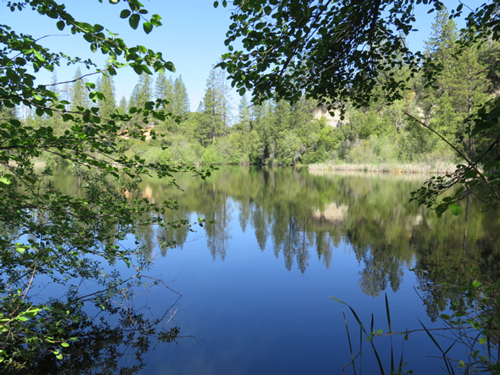A New Historical Landmark Plaque at Hirschman’s Pond
Written in 2021 by Ellen Hagan, Susan Wiesner, and Patricia Fuenzalida

The Nevada County Historical Landmarks Commission, Nevada County, and Nevada City have approved the designation of Hirschman’s Pond as a historical landmark and a plaque will mark the site. GCHNA was asked to fund the plaque and voted unanimously to do so.
The plaque will read:
“Nevada County’s diverse Gold Rush population included a large Jewish community. Most were immigrants from Europe, attracted by the opportunity to make their fortunes and by the County’s relative freedom and absence of discrimination against Jews. Many were merchants and many were miners. One of the more successful miners was Leb Hirschman (1823 – 1893), a native of Bavaria, who arrived here in the early 1850’s, and mined around Oustamah Hill. In 1866, Hirschman, Grover & Co. purchased the American Hill Diggins, one of the principal hydraulic mines in Nevada City, and operated it for many years. This pond, on the site of the mine, bears his name.
Plaque dedicated 2021 by the Nevada County Historical Landmarks Commission in cooperation with the Greater Cement Hill Neighborhood Association.”
The decision to fund the plaque has created some controversy. In the interest of transparency, here is a brief history outlining how the decision was made. At the April 5th GCHNA Steering Committee meeting, Randy Newsome, a Steering Committee member, asked on behalf of the Nevada County Historical Landmarks Commission for GCHNA’s support in funding the plaque. In general, members were enthusiastic about the idea of correcting a historical inaccuracy about the source of the pond’s name and participating with the County and City on a project in one of the Open Space Lands adjacent to our neighborhood. No objections were raised in the discussion and the Steering Committee voted unanimously to approve a motion to support the plaque.
At the August Steering Committee meeting, Richard Katz, a GCHNA member, voiced his concern about GCHNA’s role in commissioning the plaque. By agreeing to fund the plaque, GCHNA was authorizing the approval process of the landmark designation to go forward. Richard expressed concerns that the wording of the plaque should reflect a broader understanding of the historical context including a reference to the Nisenan Rancheria and the negative environmental effects of the Gold Rush and hydraulic mining. GCHNA had no role in creating the wording of the plaque which was composed by the Landmarks Commission.
Richard Katz and others asked that GCHNA reconsider its support in part because the GCHNA process leading to the decision to fund the plaque did not have adequate discussion within our neighborhood and with the greater community.
After the August meeting, Patricia solicited comments from members, reviewed input and various options, and talked directly with Bernie Zimmerman from the Landmarks Commission to clarify the Commission’s procedures. After thoughtful consideration among the GCHNA officers and some Steering Committee members, it was decided that GCHNA would honor its commitment to fund the plaque with the wording as approved by the County Landmarks Commission and Nevada City (who owns the property).
